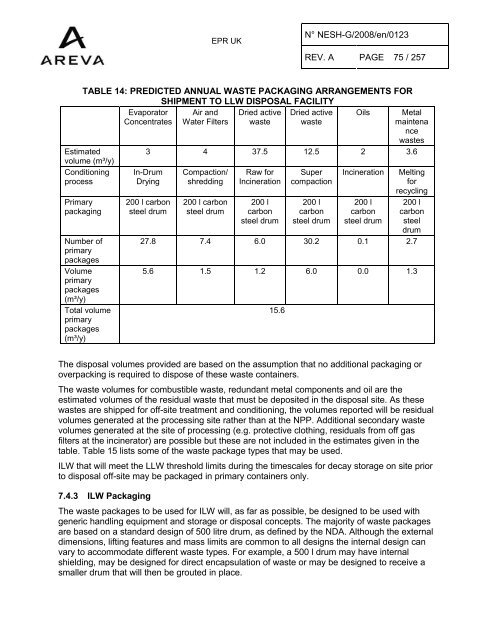Solid Radioactive Waste Strategy Report.pdf - UK EPR
Solid Radioactive Waste Strategy Report.pdf - UK EPR
Solid Radioactive Waste Strategy Report.pdf - UK EPR
Create successful ePaper yourself
Turn your PDF publications into a flip-book with our unique Google optimized e-Paper software.
<strong>EPR</strong> <strong>UK</strong><br />
N° NESH-G/2008/en/0123<br />
REV. A PAGE 75 / 257<br />
TABLE 14: PREDICTED ANNUAL WASTE PACKAGING ARRANGEMENTS FOR<br />
SHIPMENT TO LLW DISPOSAL FACILITY<br />
Evaporator<br />
Concentrates<br />
Air and<br />
Water Filters<br />
Dried active<br />
waste<br />
Dried active<br />
waste<br />
Oils Metal<br />
maintena<br />
nce<br />
wastes<br />
Estimated<br />
volume (m³/y)<br />
3 4 37.5 12.5 2 3.6<br />
Conditioning<br />
process<br />
Primary<br />
packaging<br />
Number of<br />
primary<br />
packages<br />
Volume<br />
primary<br />
packages<br />
(m³/y)<br />
Total volume<br />
primary<br />
packages<br />
(m³/y)<br />
In-Drum<br />
Drying<br />
200 l carbon<br />
steel drum<br />
Compaction/<br />
shredding<br />
200 l carbon<br />
steel drum<br />
Raw for<br />
Incineration<br />
200 l<br />
carbon<br />
steel drum<br />
Super<br />
compaction<br />
200 l<br />
carbon<br />
steel drum<br />
Incineration<br />
200 l<br />
carbon<br />
steel drum<br />
Melting<br />
for<br />
recycling<br />
200 l<br />
carbon<br />
steel<br />
drum<br />
27.8 7.4 6.0 30.2 0.1 2.7<br />
5.6 1.5 1.2 6.0 0.0 1.3<br />
15.6<br />
The disposal volumes provided are based on the assumption that no additional packaging or<br />
overpacking is required to dispose of these waste containers.<br />
The waste volumes for combustible waste, redundant metal components and oil are the<br />
estimated volumes of the residual waste that must be deposited in the disposal site. As these<br />
wastes are shipped for off-site treatment and conditioning, the volumes reported will be residual<br />
volumes generated at the processing site rather than at the NPP. Additional secondary waste<br />
volumes generated at the site of processing (e.g. protective clothing, residuals from off gas<br />
filters at the incinerator) are possible but these are not included in the estimates given in the<br />
table. Table 15 lists some of the waste package types that may be used.<br />
ILW that will meet the LLW threshold limits during the timescales for decay storage on site prior<br />
to disposal off-site may be packaged in primary containers only.<br />
7.4.3 ILW Packaging<br />
The waste packages to be used for ILW will, as far as possible, be designed to be used with<br />
generic handling equipment and storage or disposal concepts. The majority of waste packages<br />
are based on a standard design of 500 litre drum, as defined by the NDA. Although the external<br />
dimensions, lifting features and mass limits are common to all designs the internal design can<br />
vary to accommodate different waste types. For example, a 500 l drum may have internal<br />
shielding, may be designed for direct encapsulation of waste or may be designed to receive a<br />
smaller drum that will then be grouted in place.

















